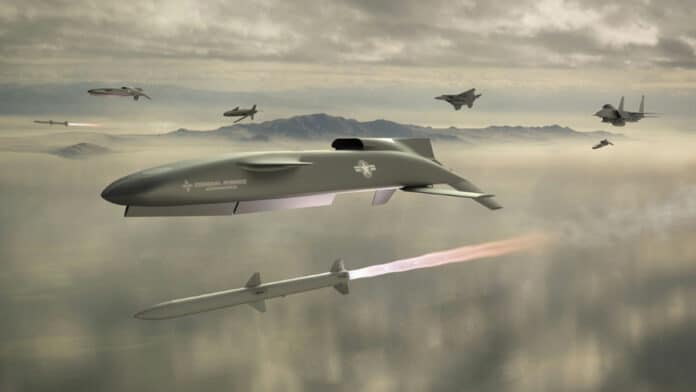General Atomics Aeronautical Systems, Inc. (GA-ASI) and the Defense Advanced Research Projects Agency (DARPA) are readying their fighter-launched LongShot uncrewed aircraft capable of firing air-to-air missiles for the flight-testing phase.
General Atomics says that it hopes to begin flight testing this drone before the end of the year. The drone could give fighters and bombers new flexibility to engage aerial threats across longer distances.
DARPA’s LongShot program is centered on developing an air-launched unmanned air vehicle (UAV) with the ability to employ multiple air-to-air weapons. Back in 2021, DARPA announced that it awarded its first round of LongShot contracts to General Atomics, Lockheed Martin, and Northrop Grumman for preliminary Phase I design work, but work on the project had actually begun the previous year. The objective is to develop a novel UAV that can significantly extend engagement ranges, increase mission effectiveness, and reduce the risk to manned aircraft.
Current air superiority concepts rely heavily on advanced manned fighter aircraft to provide a penetrating counter-air capability to effectively deliver weapons. It is envisioned that LongShot will increase the survivability of manned platforms by allowing them to be at standoff ranges far away from enemy threats while an air-launched LongShot UAV efficiently closes the gap to take more effective missile shots.
Begun in 2020, General Atomics was competitively awarded a contract to develop DARPA’s concept for disruptive air combat operations through the demonstration of an air-launched unmanned air vehicle (UAV) with the ability to employ multiple air-to-air weapons. The concept seeks to significantly enhance the engagement range and mission effectiveness of current 4th generation fighters and air-to-air missiles.
Over the last three years, GA-ASI has been working on multiple vehicle designs to optimize performance, and they will complete the design and begin flight testing in 2024. The testing will verify the basic handling characteristics of the vehicle and lay the foundation for follow-on development and testing.
“We are extremely excited to get in the air!” said Mike Atwood, Vice President of Advanced Aircraft Programs at GA-ASI. “Flight testing will validate digital designs that have been refined throughout the course of the project. General Atomics is dedicated to leveraging this process to rapidly deliver innovative unmanned capabilities for national defense.”
